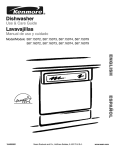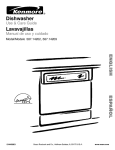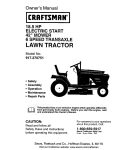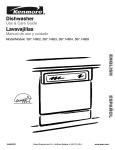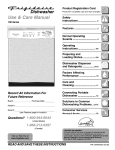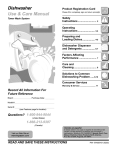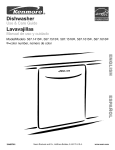Download Sears 587.14002 Use & care guide
Transcript
® Dishwasher Use & Care Guide Lavava"llas Manual de uso y cuidado Model/Modelo 154407601 587.14000, 587.14001,587.14002, 587.14008, 587.14009 Sears Roebuck and Co., Hoffman Estates, IL 60179 U.S.A. www.sears.com Table of Contents Warranty .......................................................................... 2 Safety Instructions ......................................................... 3 Operating Instructions ................................................... 4 Preparing and Loading Dishes ............................ 5-6 Dishwasher Dispenser and Detergents ..................... 7-8 Factors Affecting Performance ...................................... 8 Care and Cleaning .......................................................... 9 Solutions to Common Dishwashing Problems .... 10-11 Service ........................................................... Sears Dishwasher Back Cover Warranty FULL ONE -YEAR WARRANTY ON DISHWASHER For one year from the first day of use in your home, Sears will repair, free of charge, or workmanship which appear in this dishwasher. FULL TEN-YEAR DOOR PANEL WARRANTY AGAINST defects in material LEAKS IN THE TUB AND INNER For ten years from the first day of use in your home, if a leak should occur as a result of failure of the tub or inner door panel due to cracking, chipping, or peeling, Sears will replace, free of charge, the tub or inner door panel. If the dishwasher only 90 days. is subjected Warranty service is available States. This warranty applies This warranty state. to other than private family use, the above warranty coverage by contacting the nearest Sears Service Center/Department only while this product is in use in the United States. gives you specific is effective in the United legal rights, and you may also have other rights which vary from state to Sears, Roebuck and Co., Dept. 817WA, Hoffman Estates, IL 60179 The model number of your automatic inside the dishwasher door. dishwasher is found on the serial plate fastened to the tub wall just All repair parts are available for immediate purchase or special order when you visit your nearest Sears Service Center, or the Service Department at most Sears Stores. To request service or order parts by phone, call the toll free numbers listed on the back cover. When requesting • • • Product Type Part Number Model Number • Part Description service for or ordering parts, always provide the following information: Important Safety Instructions Store dishwasher detergent out of the reach of children. This symbol will help alert you to such dangers as personal injury, burns, fire, and electrical shock. and rinse agents Do not wash plastic items unless marked "dishwasher safe" or the equivalent. Check with manufacturer for recommendations, if not marked. Items that are not dishwasher safe may melt and create a potential If the dishwasher drains into a food disposer, make sure disposer is completely empty before running dishwasher. To reduce the risk of fire, electrical shock, or injury when using your dishwasher, follow basic precautions including the following: • Read all instructions dishwasher. • Use your dishwasher only as instructed Use and Care Guide. Disconnect electrical power to dishwasher before servicing. Repairs should technician. before using your Do not touch the heating immediately after use. When • To avoid entrapment and/or suffocation, remove door or door latch mechanism from any dishwasher that is discarded or not in use. during or loading items to be washed: - Load sharp items and knives with the handles up to reduce the risk of cut-type injuries. This dishwasher is designed to operate on regular house current (120 V, 60 Hz). Use a circuit equipped with a 15 ampere fuse or circuit breaker. Use a 20 ampere fuse if dishwasher is connected with a food waste disposer. Do not operate dishwasher unless all enclosure panels are in their proper place. element - Locate sharp items and knives so that they are not likely to damage the door seal or tub. DISHWASHER MUST BE ELECTRICALLY GROUNDED. Read the Installation Instructions for details. • be done by a qualified Do not tamper with controls. in this Instructions appearing in this Use and Care Guide are not meant to cover every possible condition and situation that may occur. Practice common sense and caution when installing, operating and maintaining any appliance. • fire hazard. Under certain conditions, hydrogen gas may be produced in a hot water system that has not been used for 2 weeks or more. HYDROGEN GAS IS EXPLOSIVE. If hot water system has not been used for such a period, before using dishwasher, turn on all hot water faucets and let water flow from each for several minutes. This will release any accumulated hydrogen gas. HYDROGEN GAS IS FLAMMABLE. Do not smoke or use an open flame during this time. Do not store or use combustible materials, gasoline or other flammable vapors and liquids in the vicinity of this or any other appliance. Keep young children and infants away from dishwasher when it is operating. Do not let children abuse, sit, stand or play on door or racks of a dishwasher. • SAVE THESE INSTRUCTIONS Use only detergents and rinse agents recommended for use in a dishwasher. Printed in U.S.A. 3 Operating Instructions Vent Getting Latch Started 1. Load dishwasher Dishes). 2. Add detergent Detergents). (See Preparing (See Dishwasher 3. Add rinse aid, if needed 4. Select desired Options). and Loading Dispenser 5. Turn dial clockwise Chart). & 6. Run hot water faucet nearest water is hot. Turn water off. (See Rinse Aid). energy OPTIONS to select cycle (See Cycle dishwasher until 7. To start, close door to latch. (See Energy Cycle To Select Chart Cycles Description Cycle Water (approx.) Time (approx.) Washes/ Rinses Heavy Wash For pots, pans, casseroles and dinnerware with driedon or baked-on soils. • Select desired OPTIONS. • Turn dial to HEAVY WASH. 8.4 gal. 31.8 liters 103 min.* 2 washes 5 rinses Normal Wash For regularly soiled dishes and silverware. • Select desired OPTIONS. • Turn dial to NORMAL WASH. 7.2 gal. 27.3 liters 95 min.* 2 washes 4 rinses • Includes dry time. Energy Options Heat Dry On Option HEAT DRY ON option provides faster drying since the heating element is on during the drying portion of the cycle. Heat Dry Off Option HEAT DRY OFF option saves electricity since the heating element is off during the drying portion of the cycle. To speed drying process, open the door slightly after the cycle is complete. Some water droplets may remain on door and tub and in areas where dishes touch silverware basket and rack. With either option, you may see water vapor coming from vent during drying portion of cycle. The drying option may be changed at any time during the cycle and affects only the drying period. Preparing and Loading Dishes Dish Preparation Loading Scrape away large pieces of food, bones, pits, toothpicks, etc. The continuous filtered wash The top rack is designed for cups, glasses, plates, saucers and bowls. system will remove remaining food particles. Burned-on foods should be loosened before loading. Empty liquids from glasses Load glasses in top rack. Damage placed in bottom rack. and cups. washing Damage may occur if delicate items touch each other during dishwasher operation. Long-handled top rack. knives and utensils can be placed in before items in question. If the dishwasher be sure starting may Load items with open ends facing down for better cleaning and draining. Load racks so that large items do not prevent the detergent dispenser from opening. recommendations small may occur if Load plastic items in top rack only. Melting occur if placed in bottom rack. Foods such as mustard, mayonnaise, vinegar, lemon juice and tomato based products may cause discoloration of stainless steel and plastics if allowed to sit for a long period of time. Unless the dishwasher is to be operated at once, it is best to rinse off these food soils. Check manufacturer's the Top Rack drains into a food disposer, disposer is completely dishwasher. empty before Loading the Bottom Place plates and platters touch. Rack so that they do not Place bowls, casseroles and sauce pans with the soiled surface facing down or toward the center. Tilt slightly for better drainage. Be sure pan handles do not protrude through bottom of the rack and block the spray arm rotation. the Do not block tower protector. 5 Preparing Loading Basket and Loading the Silverware Mix spoons, forks and knives to prevent nesting. Mixing items gives better cleaning and drying. For safety, load sharp knives and forks with handles up. Be sure nothing protrudes through bottom basket or rack to block the spray arm. Do not mix silver and stainless the silver finish. of to avoid damaging Dishes (continued) Dishwasher Dispenser & Detergents Filling the Detergent Dispenser The detergent dispenser has one covered and one uncovered cup. Detergent in the uncovered cup falls into the dishwasher when the door is closed. The covered detergent. cup opens automatically How much Detergent to release Detergent Heavy Wash or Normal Wash 2 teaspoons (each cup1/4 full) • Add detergent • Store detergent in a cool, dry location. caked detergent will not dissolve just before starting cycle. Moist or properly. Pre Wash Cup Main Wash grains per gallon. Using too little detergent can result in poor cleaning and hard water filming or spotting. Using too much detergent in soft water can cause a permanent film called etching. Your local water company, water softener company or county extension agent can tell you the water hardness in your area. Soft Water (0.3 grains) Use only fresh automatic dishwashing detergent. Other detergents will cause oversudsing. to use The amount of detergent to use depends on the water hardness. Water hardness is measured in Cycle • Cover Usage Medium Hard Water (4-8 grains) 5 teaspoons (each cup-fill to line above "Regular") Guide Hard Water (9-t 2 grains) 8 teaspoons (each cupcompletely full) Very Hard Water* (over 12 grains) Each CupCompletely Full (water softener recommended) *Note: For very hard water, detergent alone may not be enough. A water softener is recommended to improve water quality and dishwashing performance. Try adding more detergent at the beginning of the main wash portion of the cycle. As a rule, use 1 teaspoon for each grain above 12. Unlatch the door, open slowly and add detergent to the bottom of the tub. Close the door to latch and the dishwasher will continue through the cycle. 7 Dishwasher Dispenser & Detergents (continued) Factors Affecting Performance Rinse Aid Water Rinse aid greatly improves drying and reduces water spots and filming. Water "sheets" off dishes rather than forming water droplets that cling and leave spots. The hot water line to the dishwasher must provide water pressure between 20 and 120 psi. A dispenser, located next to the detergent cup, automatically releases a measured amount of rinse aid during the last rinse. If spotting and poor drying are problems, increase the amount of rinse aid dispensed by rotating the dial to a higher number. The dial is located under the dispenser cap. The indicator will be dark when full and will show clear when it is time to refill. To add liquid rinse aid, turn dispenser cap 1/4 turn counterclockwise and lift out. Pour in rinse aid until liquid touches the indicated fill level. Replace cap. Do not overfill since this can cause oversudsing. Wipe up any spills with a damp cloth. Low water pressure may occur when laundry or showers are in operation. Wait until water use is reduced before starting dishwasher. Water for 35 to 140 washes, Temperature Hot water is needed for best dishwashing and drying results. Water entering dishwasher should be at least 120°F (49°C) to give satisfactory results. To check water temperature entering dishwasher: • Turn on hot water faucet nearest dishwasher for several minutes to clear cool water from • • The dispenser holds enough depending on setting. Pressure pipes. Hold a candy or meat thermometer in stream of water to check the temperature. If temperature is below 120°F (49°C), have a qualified person raise the hot water heater thermostat setting. Important: Before starting a cycle, run hot water through faucet to clear cool water from pipe. Dispenser Opening Indicator RINSE AID Adjustable Dispenser Cap setting IIIIIIIIIIIIIIIW Care and Cleaning Care of Drain Air Gap If a drain air gap was installed for your built-in dishwasher, check to make sure it is clean so the dishwasher will drain properly. A drain air gap is usually mounted on countertop and can be inspected by removing the cover. This is not part of your dishwasher and is not covered by warranty. Burn Hazard Allow heating element to cool before cleaning the interior. Failure to do so can result in burns. Outside-occasionally nonabrasive detergent wipe with a mild and water. Rinse and dry. Property Damage Hazard Ineide--The inside of the dishwasher, Freezing temperatures may cause water lines to rupture. Be sure all supply lines to and circulating lines within dishwasher are protected. including the filter, is self-cleaning with normal use. If needed, clean around the tub gasket area with a damp cloth. Heating Failure to do so could result in property damage. element Winterizing A dishwasher left in an unheated place should be protected from freezing. Have a qualified person do the following: Filtel _ To Disconnect Spray arm/tower Overfill Protector--Keeps Turn off electrical power to the dishwasher the supply source by removing fuses or tripping circuit breaker. 2. Shut off water supply. 3. Place a pan under the inlet valve. Disconnect water line from inlet valve and drain into pan. 4. Disconnect drain line from pump and drain water into pan. Note: See Installations Instructions at for more details. dishwasher from overfilling and is located in the left front corner of the tub. • 1. assembly Note: Hard water may cause lime deposit buildup on the interior of the dishwasher. For cleaning instructions see "Removing Spots and Film" section. Service: To Restore Clean occasionally with household cleaner containing vinegar or bleach to dissolve any buildup. Overfill Protector should move up and down freely about one inch. If it does not move, lift and clean underneath. Service: 1. Reconnect the water, drain, and electrical power supply. 2. Turn on water and electrical 3. Fill both detergent cups and run dishwasher through a NORMAL cycle. 4. Check connections leak. Note: See Installations details. 9 power supply. to make sure they do not Instructions for more Solutions to Common Dishwashing Glassware/Flatware Before calling for service, review this list. It may save you both time and expense.This list includes common experiences that are not the result of defective workmanship or material in your dishwasher. • • • • • • • • Choose another cycle for longer washing time. Check rack loading section for proper loading-avoid nesting items. Home water pressure may be too low--should be 20 to 120 pounds per square inch (psi). Check incoming water temperature. It should be at least 120°F (49°C). (See Factors Affecting Performance.) Check water hardness. For extremely hard water, it may be necessary to install a water softener. (See Detergent Chart.) Use fresh detergent. Check to make sure tower in lower rack is not blocked. • • • • • • • • • Select HEAT DRY ON option. Make sure the rinse aid dispenser is filled. Increase the amount of rinse aid. (See Rinse Aid.) Check the incoming water temperature. Be sure it is at least 120°F (49°C). Check for proper loading--avoid nesting items. Plastic items may need to be towel dried. Cups with a concave bottom will collect water. • Dishware • • • • • • Check being Filling Home should to see that proper amount of detergent is used. Also, check phosphate level. (See the Detergent Dispenser.) water pressure may be too low--it be 20 to 120 pounds per square inch Dishware Dishes not Dry • • • Check water hardness. For extremely hard water, it may be necessary to install a water softener. (See Detergent Chart.) Water temperature may be low. Avoid extremely low or high temperatures. (See Factors Affecting Performance.) Avoid overloading and improper loading. (See Preparing and Loading Dishes.) Use fresh detergent. Old detergent is ineffective. (psi). the spray arm, Make sure items are not blocking preventing it from rotating. Spotted or Cloudy Food Soils Left on Dishes • • Problems • • Chipped Load with care and do not overload. (See Preparing and Loading dishes.) Place delicate items in top rack. Place glasses securely against pins and not over pins. Load items so they are secure and don't jar loose when moving racks in and out. Move racks in and out slowly. Make sure tall glasses and stemware will clear top of tub when rack is pushed in. Fine antique china and crystal should be handwashed. • Stained or Discolored Tea and coffee can stain cups. Remove the stains by hand washing in a solution of 1/2cup (120 ml) bleach and one quart (1 L) of warm water. Rinse thoroughly. Iron deposits in water can cause a yellow or brown film. A special filter installed in the water supply line will correct this problem. (See Removing Spots and Film.) Aluminum utensils can leave gray/black marks when they rub against other items. Load properly. Certain high acid foods can cause discoloration of stainless steel and plastics if allowed to sit for a long period. Rinse by hand if not operating dishwasher at once. Mixing stainless steel and silver utensils in silverware basket can cause pitting of the stainless steel blades. Avoid mixing stainless steel and silver. Etching • Using too much detergent in soft or softened water causes this film that cannot be removed. • Adjust the amount of detergent based on the water hardness. (Check Detergent Chart.) Lower the water temperature. Use the HEAT DRY OFF option. • • Dishwasher Won't Fill Is water supply turned on? Does overfill protector move up and down freely? (See Overfill Protector section.) Normal water fill covers filter area. 10 Solutions to Common Dishwashing Problems |continued) Dishwasher • • • Leaks Dishwasher Use only fresh detergent designed for automatic dishwashers. Measure detergent carefully. Try a different brand. Spilled rinse aid can cause foam and lead to overflowing. Wipe up any spills with damp cloth. Check to see that dishwasher is level. (See Installation Instructions.) • • • Has an Odor Soiled dishes left in dishwasher too long can create an odor. Rinse dishes if not running dishwasher at once. There will be a "new" smell when first installed. This is normal. Check to see if unit is draining properly. (See Dishwasher Does Not Drain Properly.) Normal Sounds You Will Hear Stains on Tub Interior • • Normal sounds include water fill, water circulation and motor sounds. Water in Bottom of Tub • Water left in bottom of tub after cycle is complete is not normal. If water remains in the bottom of the tub, dishwasher may not be draining properly. (See Dishwasher Does Not Drain Properly.) Removing Spots and Film Hard water can cause lime deposit buildup on the interior of the dishwasher. Dishes and glasses may also get spots and film for a number of reasons. (See Glassware/Flatware Spotted or Cloudy section.) To remove buildup, spots and film, clean using the following instructions: Vapor at Vent • Water vapor escapes from the vent when the dishwasher is operating. This is normal. Dishwasher Won't Run • Check to see if circuit fuse is blown. • • Make sure water supply is turned on. Check to see if cycle is set correctly. (See Operating Instructions.) Make sure door is closed and latched. • breaker is tripped or if a 1. Load clean dishes and glasses in normal manner. Do not load any metal utensils or silverware. 2. 3. Do not add detergent. Turn dial to NORMAL WASH. Close and latch door to start. Allow dishwasher to run for 40 minutes to 4. Dishwasher • Does Not Drain Properly • If unit is hooked up to a food waste disposer, make sure the disposer is empty. Check to see if the knockout plug has been removed from inside the food waste disposer inlet. Check to see if drain hose is kinked. • Make sure cycle is complete, • Detergent • • • • 5. 6. reach the main wash portion of cycle. Unlatch and open door and pour 2 cups of white vinegar into the bottom of dishwasher. Close and latch door and allow the cycle to finish. Note: If these conditions persist, softener should be considered. not in a pause. Left in Cups Detergent may be old. Discard detergent. Be sure water action can reach Check to see if cycle has been Make sure items do not prevent dispenser Washing large amounts of dishware with tomato based soil can cause a pink/orange appearance. This will not affect performance and will gradually fade over time. Pre-rinsing will reduce the chance of staining. Using HEAT DRY OFF option will lessen staining. and use fresh the dispenser. completed. the detergent from opening. 11 a home water Notes 12 For repair of major appliances in your home... no matter who made it, no matter who sold it! 1-800-4-MY-HOME ® Anytime, day or night (U.S.A. and Canada) (1-800-469-4663) www.sears.com www.sears.ca For repair of carry-in products like vacuums, lawn equipment, and electronics, call for the location of your nearest Sears Parts and Repair Center, 1-800-488-1222 Anytime, day or night (U.S.A. only) www.sears.com For the replacement parts, accessories and owner's manuals that you need to do-it-yourself, call Sears PartsDirectSU! 1-800-366-PART 6 a.m.-11 p.m. CST, 7 days a week (U.S.A. only) (1-800-366-7278) www.sears.com/partsdirect To purchase or inquire about a Sears Service Agreement or Sears Maintenance Agreement: 1-800-827-6655 (U.S.A.) 1-800-361-6655 7 a.m.-5 p.m. CST, Mon.-Sat. 9 a.m.-8 p.m. EST, M-F, 4 p.m. Sat. Para pedir servicio de reparaci6n a domicilio, y para ordenar piezas: 1-888-SU-HOGAR (Canada) Au Canada, pour service 1-877-LE-FOYER sM en fran£ais: Mc (1-800-533-6937) www.sears.ca (1-888-784-6427) HomeCentral ® ® Registered Trademark/ TM ® Marca Regislrada / MC Marque de commerce TM Trademark/ _M Marca de FAbrica / MD / Marque d_pos_e Service Mark of Sears, Roebuck SM Marca de Servicio de Sears, de Sears, Roebuck and Co. Roebuck and Co. Part No. 154407601 © Sears, Roebuck and Co. 24 and Co.













